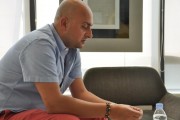Having taken up the role of Chief Creative Officer of Ogilvy & Mather China in July 2011, Graham Fink recently enjoyed his one year anniversary at Ogilvy.
Graham is a veteran of iconic agencies CDP and Saatchi & Saatchi and one of the most recognised faces in advertising. He has created some of advertising’s most memorable campaigns and won countless awards for his work.
Some of his many achievements include becoming the youngest ever president of the Design & Art Directors Association, creating ‘The Art School’, being involved in the successful London Olympic bid and winning four BAFTA’s!
This is part two of a two part interview with Graham where he shares his experiences, insights and personal experiences in advertising.
The Chinese Ad industry is mostly run by non-Chinese people, true or false?
It’s an interesting question because I personally believe that the real people running the agency are those actually producing the work. Take them away and the agency would simply stop running. A bit like a big ship where all the engineers are working hard to keep the engines running. Of course you need a captain to make sure each department is working to the best of its ability. But both need each other. So my answer is both true and false.
What are the 3 biggest lessons you’ve learnt from your first year in China?
Take a later lunch than everyone else or you will have to wait ages to get into the lift!! But seriously… I’ve learnt a lot about the importance of not losing face (by losing face myself).
I’ve learnt that even if the place I’m flying to seems about 1 cm away on my Chinese map it still takes a long time to get there. I’ve also learnt that Weibo is not just a media platform, it’s a way of life.
“Walking through the hutongs over the weekend I see a lot of photo opportunities while I’m learning about Chinese culture. I love the vividness of this red jacket in the shot and the way it plays off the pink of the wall below.” – Graham Fink
How would you describe the current state of creativity in China? How do you see it in 5 years?
As I’ve said, the current state on a world league of creativity is well down the list, but catching up fast.
In 5 years, who knows, hopefully China can be producing consistently world class creative work, rather than the odd blip. But for this to happen there needs to be a shift in clients’ thinking. It’s no coincidence that the very best creative work comes from clients who work collaboratively with their agencies and deliver great creative briefs with a single, clear proposition. They must be brave too, in order to buy work that will cut through and be remembered. And overall there must be respect for the agency. At best, agencies should be producing highly original work that slightly scares their clients as it’s something that hasn’t been seen before and will challenge people. Currently too much work is just copies of work from the West and/or rather muddled in it’s thinking with too many messages. So many commercials are just shouting at the consumer rather than engaging them in a story. This needs to change for China to catch up.
How would you describe the creative talent on show at the recent Portfolio Night in Shanghai that Ogilvy hosted?
To be honest, I was so pleased we had a record amount of people participating, not just with top Executive/Creative Directors but also students that I didn’t mind the fact that the overall standard was not that high. Having said that, only a small number of people stood out from the crowd. But the evening was full of electricity and the atmosphere was buzzing. Ogilvy also took on a number of students as interns. We are definitely going to do it again next year.
What’s the most important thing you look for when you hire a creative team to work at Ogilvy China?
A great attitude above all else. One thing I have found is that some creative people do this as a job and I never have thought of it as a ‘job’. If you do something you really love doing, you will never have to do a day’s work in your life. I think Confucious said that first. So I want people who will put their heart and soul into bringing great ideas to life. They should be prepared to work 25/7 simply because they love ideas, it excites them, and if their creative director says it’s not good enough they will go away and create something even better.
How would you describe the advertiser’s attitudes in China?
I’ve found that there are many different attitudes. And rightly so.
How does the culture of Ogilvy compare to that of M&C Saatchi?
In a lot of ways it is very similar. Same kind of problems, and same old arguments in most cases which makes me laugh. For all the thousands of miles between the two agencies and the hugely different cultures (Chinese and English), most basic human traits remain. Man as a being on this planet is fundamentally flawed. We somehow always manage to make a relatively simple process so much harder than it needs to be.
We’re interested in your personal journey into advertising. Can you tell us about that?
I love the creative world and I think that advertising at its best is an art form. Great creative work, whether it’s a painting or a film or a print ad, has the power to transform you. It can change the way you feel, it can give you goose bumps, it can make your heart beat a little faster and even change your behavior.
I find it’s always challenging and therefore pushes me everyday. I learn lessons everyday and that hopefully makes me a bit wiser. I’ve never lost my enthusiasm though in all the years I’ve been doing it. I see the obstacles I come up against as a mountain full of treasure. It’s hard to overcome them at first but if you can do it you feel so rewarded. I remember going to my first interview for a job at CDP (then London’s hottest advertising agency) when I was still a student. They turned me down saying they wanted someone older with a lot more experience. So I went home that night,dyed my hair grey and found an old overcoat. The next day I painted wrinkles on my face, borrowed a walking stick and went back to the agency dressed up as an old man. They hired me! Ever since then I’ve believed you have to take risks to get noticed.
What’s the biggest success you’ve had in your career?
I’ve been very lucky and probably had more than my fair share. It’s nice to win awards but it’s better to do work that becomes famous and gets talked about (whether it wins awards or not). One of my favourite pieces was the British Airwys ‘FACE’ commercial with a cast of 4000 people making up a face from the air. It was one of the most talked about commercials in the world and they still play the music (Delibe’s Lakme) to this day on all British Airways flights.
What things do you advise young Chinese who are wanting to get into the industry and make a career? What’s your career advice for them?
Be yourself. Listen to everyone around you and then reject all the advice you don’t agree with. China is more known for copying and producing things for the rest of the world, but what interests me is Chinese creative people who want to create something original. This is surely where the future should be. I don’t mind if they make mistakes or even produce something rubbish as long as they are trying to do something new.
We have a young creative guy here who has come up with this great line, “it’s OK to lose face’. His rationale is that you are never going to do anything new or original unless you are prepared to take risks and screw up. Only by preparing to lose face do you stand a chance to do something that the rest of the world will look up to. I think that’s wonderful. He doesn’t know it yet but that breakthrough thinking has earned him a pay rise.
Thanks, Graham for speaking with us.












